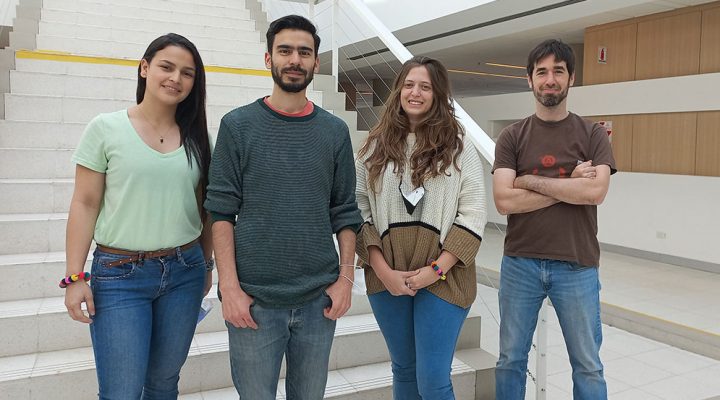BIOLOGICAL AND HEALTH SCIENCES
A new brain structure linked to fear is discovered
The study conducted by CONICET researchers reveals the centrality of this region of the brain in the conditioning of fear and lays the foundations of locating it as the therapeutic target.
The lateral habenula, a brain structure little studied so far, could play a key role in the Pavlovian conditioning of fear. This is suggested by a study published this year by Joaquin Piriz, CONICET researcher at the Institute of Physiology, Molecular Biology and Neurosciences (IFIBYNE, CONICET-UBA) and Tomas Schella, CONICET fellow at the ‘Bernardo Houssay Institute of Physiology and Biophysics’ (IFIBIO HOUSSAY, CONICET-UBA), and specialists from various scientific institutions.
Aiming at the understanding of the functioning of this brain structure, the results could contribute to the treatment of pathologies associated with the expression of fear, such as phobias, anxiety disorders, post-traumatic stress, among others. “Fear is an extreme and uncontrollable reaction to a threating stimulus,” affirm the authors in the first pages of the article published in Neuropsychopharmacology. There are two types of fears, those that are innate and those that can be learned. It is about this last type of fear and the creation of aversive memories that the study on the role of lateral habenula is carried out.
The study
“Lateral habenula participates in the encoding of negative events. In other words, when we don’t like something, the lateral habenula is activated, “indicates Piriz and continues: “We analyzed how this structure is related to the formation of fear memories.”
In order to achieve this, the scientists followed Pablovian conditioning, that is a learning paradigm according to which “an association occurs between to stimuli,” explains Sachella. Nevertheless, unlike the well-known experiment conducted by Pavlov in which he observed canine salivation in response to a stimulus announcing food, in this case the reinforcement was negative: “The sound predicted a slight discharge,” describes Piriz.
During the training, a tone was presented to a murine model that anticipated a small electric shock of one second, a protocol that does not produce temporary or permanent alterations in the study subject. “Thus, animals normally learn two things: that the presentation of the tone is dangerous and that the context in which they received the electric shock is also dangerous,” the researcher explains and adds: “Two learnings that were traditionally thought as separate.”
In parallel, it was necessary to use pharmacological and optogenetic techniques that would temporarily activate and silence the lateral habenal during the experiments with the animal model. The objective was to assess the involvement of this brain region in conditioning.
The find
“If the lateral habenula is not present, these two learnings –tone and context– do not occur separately, but originate together,” Sachella explains. This suggests that the analyzed structured would participate in the conditioning of fear.
For Piriz, the lateral habenula constitutes a structure on which it is possible to act again to understand how the learning mechanisms are produced, “for example, in mistaken, pathological learning of fear which are the basis of diseases such as phobias, disorders of anxiety, post-traumatic stress, among others”, the researcher describes and adds: “Fear is generalized in such an extreme way that fear begins to appear in situations in which it should not exist so it is potentially interesting to have found a structure that regulates the generalization of fear.”
For Piriz, the lateral habenula constitutes a structure on which it is possible to act again to understand the way in which the learning mechanisms are produced, “for example in mistaken, pathological learning, of fear that are the basis of diseases such as phobias, disorders of anxiety, post-traumatic stress, among others”, points out the scientist. And he adds: “Fear is generalized in such an extreme way that fear begins to appear in situations in which it should not exist, for this, potentially, it is interesting to have found a structure that regulates the generalization of fear.”
The scientists highlight the implementation of the Plavlovian paradigm. “It provided a clear protocol in which to look at the circuits involved in creating aversive memory and how the lateral habenula is involved in the formation of that memory,” Sachella states.
In the future, the researchers intend to continue exploring the fear generalization hypothesis and the implications of this brain structure in the process. “Incorporating it and associating it with the learning of fear could also have a translational side,” Piriz reflects on this key region for the brain and Sachella adds: “It opens up the possibility that it could be a target to treat diseases associated with abnormalities in the expression of fear.”
“Incorporating it and associating it with the learning of fear could also have a translational side,” Piriz reflects on this region. brain key. Sachella agrees: “It opens up the possibility that it could be a target for treating diseases associated with abnormalities in the expression of fear.”
By Yasmín Noel Daus
